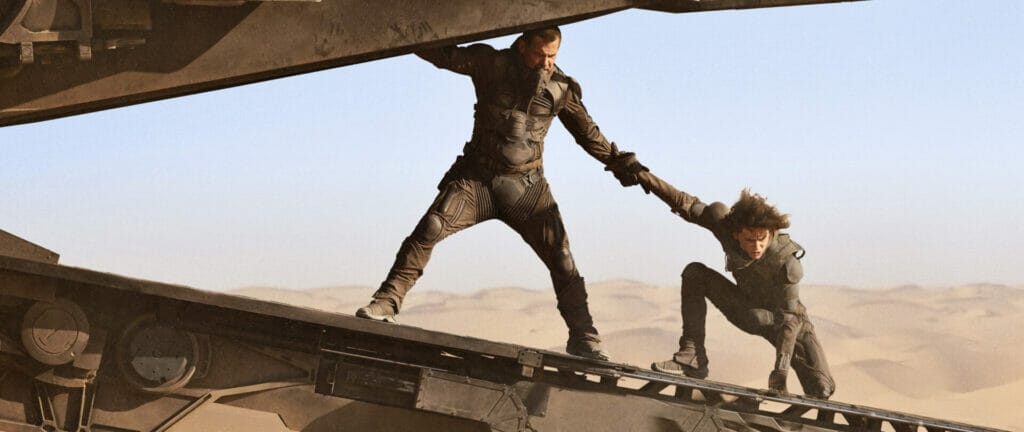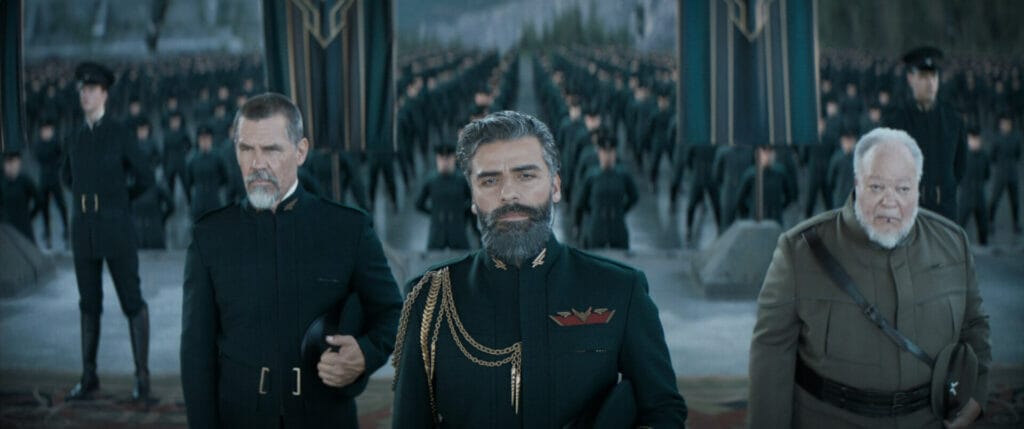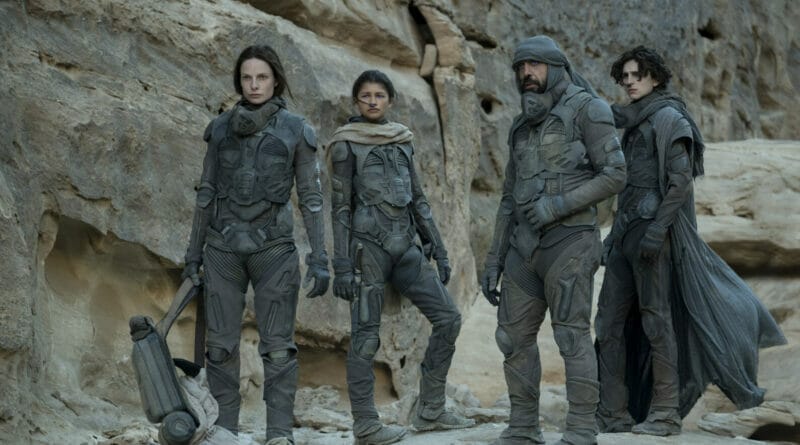In scope and scale, “Dune” is worth its weight in gold. Its story may get lost in translation but let’s hope the sequel can alleviate its gaps.
How to describe “Dune”?… Hmmm… BIG!!! “Dune” is indeed big. How big, you ask? There’s a weird thing that happens to me sometimes before I fall asleep at night. I close my eyes and I perceive different locations much wider and bigger than I remember them. Does that happen to anybody else? It’s incredibly disorienting and produces a weird sense of anxiety in me. I just looked it up, It’s a scientific process called: Phosphenes. Some of you reading might relate. Anyway, these wide-open spaces I see when I close my eyes as I doze off are reminiscent of Dune’s grand cinematic scope.
Everyone says this but the credits rolled and I couldn’t imagine watching this film, on my phone, my TV, or even my smart fridge. I saw it in IMAX and I suggest you do the same. If I’m being brutally honest, I didn’t even think that IMAX was big enough. A scope of this magnitude has rarely been captured with such gravity. It compares to none of its modern contemporaries, Nolan’s “Interstellar” and 2011’s “Mars Needs Moms” starring Seth Green included.

Denis Villeneuve returns to the sci-fi realm after “Blade Runner 2049”. What impressed me the most about “Dune” was its set-pieces. With Blade Runner, you had these sets that flared with neon colors and complex technology. Dune’s set design was a true breath of air from the conventional “Ex Machina” futurism we’re used to. “Dune” takes place in 10191, which is 8,170 years into the future. You’d expect the interiors reminiscent of the Death Star and exteriors of the original Blade Runner’s neon-infused set. But what you’d actually find are these retrospective structures and designs that pull from nature instead of some factory.
The Atreides mansion on Caladan is made of stone with a similar interior layout as the castle in Winterfell. Then we travel to Arrakis where the building structures are reminiscent of ancient Egypt. You won’t find iPads on the walls or robot butlers but there is this floating orb of light that follows you around if it’s dark. The spaceships and vehicles fit the giant scope of Villeneuve’s vision. One looks like a metal mosquito, one is shaped like a rhombus, and some people ride the giant worms. Yes, some of these vehicles look like they were designed by Elon Musk, but they look like they’re made out of stone or rock. “Dune” looks like it takes place in the futuristic stone age and in all honesty, it’s a huge breath of fresh air.

“Dune” is revolutionary in its filmmaking. I went into this film with very little knowledge of the original novel and David Lynch’s 1984 adaptation. “Dune” was uncharted territory for me and I was prepared to be enthralled by a Sci-fi flick outside of “Star Wars” and 2008’s “Space Chimps” starring Andy Samberg. Villeneuve executed his vision almost perfectly and for that, we must applaud Dune. However, at the core of the story, it felt overall soulless and restricted.
The original novel had Frank Herbert paint vivid pictures and perfectly explain the worlds he created. The 1984 adaptation had Lynch’s surreal cinematic personality to keep his film afloat. But the 2021 film has the visual personality to keep its hollow writing insignificant. I don’t feel for these characters, I have a small understanding of the worlds established, and in the end, I don’t feel complete. The film does not hold your hand through its story, character introductions, and background exposition.
Yes, the film ends on a cliffhanger and I hope we get a sequel because that would be a chance to alleviate some confusing aspects the first laid out. The mysteries feel larger than the revelations and that’s the sandpit (Ha!) Dune inevitably falls into. Going back to my very little knowledge on Dune, if you are familiar with the novel or the Lynch adaptation you’ve already done half of the work of understanding the film.

Photo Credit: Courtesy of Warner Bros. Pictures and Legendary Pictures
Caption: (L-r) JOSH BROLIN as Gurney Halleck, OSCAR ISAAC as Duke Leto Atreides, and STEPHEN MCKINLEY HENDERSON as Thufir Hawat in Warner Bros. Pictures’ and Legendary Pictures’ action-adventure “DUNE,” a Warner Bros. Pictures release.
Denis Villeneuve continues to be one of the most prolific directors of our time. Consistently crafting a compelling film with his magnificent direction and always putting visuals over the script. I can’t recall a film of his that told a story that matched the artistry of his direction other than “Prisoners.” Dune shares the same core problem as Nolan’s “Tenet.” Its massive scale completely overshadows its story, restricting it from being coherent. The sheer intensity of the score alone made me miss a few plot points.
As the day went on after my viewing, the more I forgot about the film. It’s an experience that impacts you in the theater but stays in the seat you sat in. For most movies, that’d warrant a negative review, but the initial reaction to the film will be visceral. At the moment you experience “Dune” for its massive scale. You’ll remember the experience for being quite singular but later that’s all it’ll be. “Oh, yeah. That movie WAS good.” As for the 2021 releases, there are so many films that will stick with you long after the credits roll, “Dune” unfortunately isn’t one of them.
Want to discuss things further? Hit us up on Twitter, Facebook, or Instagram. And for more film, gaming, anime, and TV news, trailers, and updates make sure to keep it locked right here at The Nerdy Basement. While you’re here, please consider supporting us on Patreon! It’s an easy way of supporting us so we can keep providing you with your Nerdy News!

